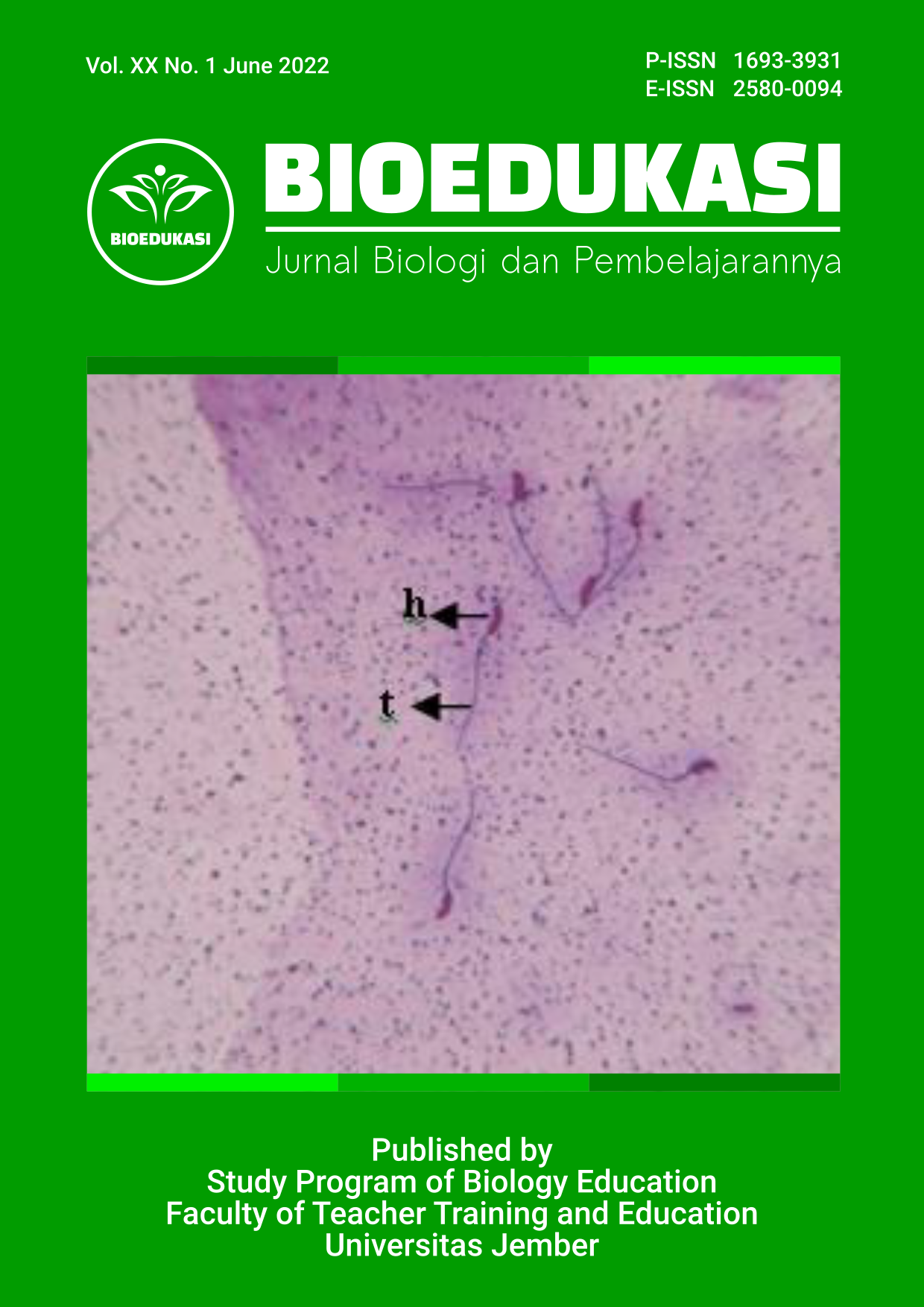COLOR BLIND PREVALENCE OF ELEMENTARY STUDENT IN SUMBERSARI SUBDISTRICT, JEMBER
DOI:
https://doi.org/10.19184/bioedu.v20i1.31199Keywords:
Color blindness, prevalence, sex linkage.Abstract
Red-green color blindness is the most common type of color blindness. Color blindness disorders occur due to genetic factors determined by the recessive gene c (color blind) which is linked to the X chromosome. This study aims to determine the prevalence and frequency of color blind alleles and to determine the pattern of inheritance of color blind genes by conducting pedigree analysis on color blindness student’s family. The research was conducted in 13 public elementary schools, Sumbersari subdistrict, Jember Regency with a multistage cluster sampling method of sampling with a total sample of 286. Detection of color blindness using Ishihara's methods. Based on the results of this study, the color blindness prevalence of elementary school students in Sumbersari subdistrict, Jember was 2.79% with the prevalence in males and female were respectively as 4.86% and 0.7%. The allele frequency of color blindness was 0.021 and the normal allele frequency was 0.979. The pedigree analysis of a color blind student family shows the gene of color blindness is inherited in a criss-cross inheritance pattern.
Downloads
References
Anwar, K., & GA. Hutagalung. 2018. Analisis penyakit buta warna dengan perancangan sistem tes dengan objek citra. Seminar Nasional Royal (SENAR). 1(1):241–244.
Ardiyan, R., H. Nasution & T.Tursina. 2019. Aplikasi tes buta warna dengan metode ishihara metode colour gradation dan metode farnsworth. Jurnal Sistem Dan Teknologi Informasi (JUSTIN). 7(4):250–256 https://doi.org/10.26418/justin.v7i4.34184
Arsal, AF. 2018. GENETICS I : Arif Arif Memahami Kehidupan. Makassar: Badan Penerbit Universitas Negeri Makassar.
Chaudhari, SV. 2013. A Survey On Color Blindness In Pharmacy Students At Wagholi, Pune. Electrical Elite Scientific Journal, 2(3), 518–524.
Crow, JF, & Kimura, M. (1970). An Introduction to Population Genetics Theory. Burgess Publishing Company.
Dhika, RV, Ernawati, & D. Andreswari.. 2014. Aplikasi tes buta warna dengan metode ishihara. Journal of Pseudocode, 1(1), 51–59.
Fareed, M., MA. Anwar, & M. Afzal. 2015. Prevalence and gene frequency of color vision impairments among children of six populations from the North Indian region. Genes and Diseases, 2(2), 211–218. https://doi.org/10.1016/j.gendis.2015.02.006
Franzco, AC, G. Gazzard, L.Tong, X. Zhang, EL. Sim, A. Fong & SM. Saw. 2008. Red-green color blindness in Singaporean children. Clinical and Experimental Ophthalmology, 36(5), 464–467. https://doi.org/10.1111/j.1442-9071.2008.01799.x
Gupta, SC, S. Saxena, S. Gupta, R. Saxena & S. Sharma. 2017. The prevalence of color blindness in middle school students of southern Bhopal. International Journal of Medical and Health Research, 3(5), 111–113.
Husain, Z., S. Syarif, S., AL.Arda & A. Aman. 2020. Aplikasi bantu buta warna berbasis android. JIKO (Journal of Informatics and Computers), 3(1), 24–30. https://doi.org/10.33387/jiko.v3i1.1634
Ishihara, S. 1994. Ishihara's Test for Color-Blindess. Kanehara & CO., LTD.
Karim, KJ, & MA. Saleem. 2013. Prevalence of Congenital Red-Green Color Vision Defects among Various Ethnic Groups of Students in Erbil City. Jordan Journal of Biological Sciences, 6(3), 235–238. https://doi.org/10.12816/0001540
Karolina, NW, M. Pharmawati, M, & I. Setyawati. 2019. Prevalensi dan frekuensi gen buta warna siswa sekolah dasar di kabupaten badung, bali, indonesia. Jurnal Biologi Udayana. 23(2):42–49. https://doi.org/10.24843/jbiounud.2019.v23.i02.p01
Khairoalsindi, OA, BM. Almasoudi, AY. Bamahfouz, AA. Alghamdi & MI. Siddiqui. 2019. Allen RC. Orbital metastases: When to suspect? When to biopsy?. Middle East Afr J Ophthalmol 2018; 25: 60-4. The Middle East African Journal of Ophthalmol, 26(3), 133-137. https://doi.org/10.4103/meajo.MEAJO
Moudgil, T., R. Arora & K. Kaur. 2016. Prevalence of Color Blindness in Children. International Journal of Medical and Dental Sciences, 5(2), 1252–1258. https://doi.org/10.19056/ijmdsjssmes/2016/v5i2/100616
Nazeer, M., S. Bashir & N. Rafiq. 2019. Color Vision Deficiency in Medical Students in Jammu & Kashmir, India. Galician Medical Journal, 26(1), 2–6. https://doi.org/10.21802/gmj.2019.1.9
Ningrum, CM. 2008. Studi Buta Warna Pada Siswa Sekolah Dasar Di Kecamatan Kaliwates Kabupaten Jember. Skripsi.
Octaviano, A., & A. Umbari. 2017. Penerapan metode ishihara untuk mendeteksi buta warna sejak dini berbasis android Journal of Informatics Universitas Pamulang. 2(1), 42–50. https://doi.org/10.32493/informatika.v2i1.1516
Pai, AC. 1992. Genetika Dasar : Ilmu Untuk Masyarakat. Jakarta: Erlangga.
Purwoko, M. 2018. Prevalensi buta warna pada mahasiswa universitas muhammadiyah Palembang. Jurnal Kedokteran Brawijaya 30(2), 159–162.
Rahmadi. 2009. Penentuan Tingkat Buta Warna Pada Metode Ishihara. Universitas Andalas.
Shah, A., R. Hussain, M. Fareed & M. Afzal. 2013. Prevalence of Red-Green color vision defects among Muslim males and females of Manipur, India. Iranian Journal of Public Health, 42(1), 16–24.
Singh, A., & S. Chahal, S. 2009. Incidence Of Color Blindness Among Some Endogamous Groups Of Bathinda District, Punjab. The Internet Journal of Biological Anthropology, 4(1), 1–5.
Smail, HO, EM. Ismael & SA. Ali. 2019. Prevalence of Color Blindness among Students of four basic schools in Koya City. Journal of Advanced Laboratory Research in Biology, 10(2), 31–34. https://doi.org/10.15171/ijer.2019.27
Stansfield, W. 1991. Genetics (2nd ed.). Penerbit Erlangga.
Sumarni. 2010. Prevalensi buta warna pada calon mahasiswa yang masuk Tadulako University. Biocelebes, 4(1), 54–59.
Wahyunita, & L. Armajin. 2019. Profil buta warna pada mahasiswa baru tahun ajaran 2018/2019. Techno, 8(1), 253–258.
Wale, MZ, Y.Abebe, Y. Adamu, A. Zelalem. 2018. Prevalence of color blindness among school children in three primary schools of Gish –Abay town district, Amhara regional state, north-west Ethiopia. BMC Ophthalmology, 18(306), 1–6. https://doi.org/10.1186/s12886-018-0970-4
Woldeamanuel, GG and TG, Geta. 2018. Prevalence of color vision deficiency among school children in Wolkite, Southern Ethiopia. BMC Research Notes, 11(1), 1–5. https://doi.org/10.1186/s13104-018-3943-z
Wulandari, AD, R. Oktarianti, S Wathon. 2020. Prevalensi buta warna siswa Sekolah Menengah Atas di kota Jember. Berkala Sainstek 8(4), 102–105. https://doi.org/10.19184/bst.v8i4.18127




 https://orcid.org/0000-0003-1920-0515
https://orcid.org/0000-0003-1920-0515